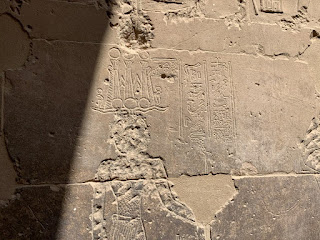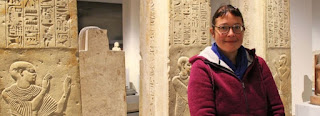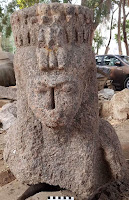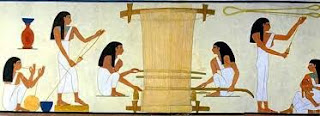Tuesday, December 31, 2019
Tuesday, December 24, 2019
Ancient Egypt News 12/24/2019
Add next here
Egypt's History of Humanity' Monuments Face Climate Change Threat
Ceiling at Karnak © Michalea Moore 2017
It’s a steamy November day in the southern Egyptian city of Luxor, and the tourists tramping through the ancient temples of Luxor and Karnak are sweating. But the city’s famed 7,000-year-old antiquities are feeling the heat too.
Increasingly high temperatures linked to climate change, as well as wilder weather, particularly heavy rains and flooding, are taking a growing toll on the ancient stonework, said Abdelhakim Elbadry, a restoration expert who works at Karnak temple.
Old Kingdom Tomb
Courtesy Mohamed Megahed
During investigation of the funerary complex of the 5th Dynasty pharaoh Djedkare Isesi (r. ca. 2381–2353 B.C.), a team from the Czech Institute of Egyptology discovered the painted tomb of a high-ranking Old Kingdom Egyptian dignitary. After descending a narrow subterranean tunnel that opened up into a series of rooms, members of the team, led by archaeologist Mohamed Megahed, found hieroglyphs on the walls announcing that a man named Khuwy was entombed within the chamber. The writing also enumerates Khuwy’s many titles, including “Secretary of the King,” “Companion of the Royal House,” and “Overseer of the Tenants of the Great House.”
A Granodiorite Colossus of Horus Unearthed in Egypt's Luxor
During excavations carried out at the Funerary Temple of king Amenhotep III, an Egyptian-German archaeological mission led by Horig Sourouzian unearthed a large part of a granodiorite colossus of a standing falcon-headed god Horus.
Sourouzian said the statue is missing the legs, and the arms are broken, but the head and torso are very well preserved.
The 1.85-metres-tall statue depicts the ancient Egyptian deity Horus wearing the divine pleated kilt held around the waist with a horizontally pleated belt.
Hunting for Hieroglyphs at Philae
Photo: Nile Scribes
In October, the Nile Scribes led their first tour to Egypt, stopping in Aswan, Luxor, and Cairo. Agilika Island, located in the river at Aswan, is now the home of Philae Temple. It was moved there in the 1960s, piece by piece, from neighbouring Philae Island, now underwater. The island is a regular spot for visitors to southern Egypt thanks to its gorgeous setting in the Nile, but we were anxious to visit the temple complex for another reason: hieroglyph hunting. Philae contains the last known instances of inscriptions that were written using both the hieroglyphic and Demotic scripts. This week we are introducing our readers to both inscriptions, and showing you how you can see them for yourself on your next visit to Philae.
Anubis Was Ancient Egypt's Jackal-headed Guard Dog of the Dead
DRE/FLICKR (CC BY-SA 2.0)
Death isn't exactly a comfortable topic of conversation in our modern culture. But in countless societies around the world and throughout time, death has been openly discussed, revered and even celebrated. Ancient Egypt is no exception — case in point, the deity Anubis, otherwise known as Inpu or Anpu, aka the god of death.
"Anubis is the Egyptian god of mummification, and one of the many deities related with the afterlife," says M. Victoria Almansa-Villatoro, Ph.D. candidate in Egyptology at Brown University. "He is usually depicted as either some sort of canid, or as a cynocephalus god."
The Story of That Famous Female Physician From Ancient Egypt Is Actually Wrong
Stzeman/Wikimedia Commons/CC BY-SA 3.0
NOTE: Don't despair. Read the end of the article. Peseshet is a genuine hero of the modern feminist struggle.Merit Ptah. In recent decades, the name of this ancient Egyptian doctor, said to have lived nearly 5,000 years ago, has become a figurehead of women in science, technology, maths, and engineering (STEM).
She is credited as being the "first woman known by name in the history of science". But there's a bit of a problem - Merit Ptah probably didn't exist. Not as described, at any rate.
‘Egypt is not Just Pyramids and Mummies’
Egyptologist Lara Weiss is curator at The National Museum of Antiquities and has been leading the VIDI research project ‘Walking Dead’ since 2017. The exhibition ‘Sakkara: Living in a necropolis’h will be on display at the museum starting March 9 next year.
Why Nikola Tesla was Obsessed with the Egyptian Pyramids
Mstyslav Chernov/Wikimedia
Nikola Tesla died somewhat unappreciated but his fame and the myth around him has continued to grow tremendously into our times. He is now perceived as the ultimate mad scientist, the one who essentially invented our times, credited with key ideas leading to smartphones, wi-fi, AC electrical supply system, and more.
Besides ideas that Tesla implemented and patented, he also had many other interests in different fields of research, some quite esoteric. One of the most unusual was his preoccupation with Egyptian pyramids, one of humanity's most mysterious and magnificent constructions.
Monday, December 16, 2019
Ancient Egypt News 12/16/2019
Sun to Illuminate Egypt’s Ancient Karnak Temple Dec. 21
Crowds of tourists and Egyptians are expected to flock to Luxor on December 21 to witness the magnificent phenomenon of the sun aligning on the Temple of Amun inside the 4,000-year-old Karnak Temple.
The annual two-hour event, starts at 6 a.m., will mark the first day of winter, as per the outstanding progressive knowledge of the ancient Egyptian.
Every year, attendees come to watch the sunlight as it falls perfectly perpendicular on the sanctuary of Amun Ra’a at the center of the temple; the sunrays then move towards the temple’s gates to reach Hatshepsut's ancient temple.
Royal Sphinx Statue Discovered in Egypt's Minya
Egyptian Ministry of Antiquities/Handout via Xinhua
An Egyptian archaeological mission uncovered on Saturday a small royal statue of a Sphinx during excavation in Minya province, south of the capital Cairo, the country's Ministry of Antiquities said in a statement.
"The statue is made of limestone with 35 cm in height and 55 cm in length," said Gamal el-Samastawy, director general of the Antiquities of Middle Egypt, a department of the ministry.
"The clear and beautiful features and details of the statue mirrored the skillfulness of the ancient Egyptian sculptor," he added.
Scientists Have Determined A Woman's Profession In Ancient Egypt Through Examining Her Mummified Remains
By analysing the dentistry of a woman who lived in Ancient Egypt, archaeologists have made a surprising discovery: her unusual profession. A video provides all the details...
With this incredible discovery, archaeologists have gone from surprise to surprise. A short time ago, a team of scientists from the University of Alberta, in Canada, analysed the teeth of a woman who lived 4000 years ago, in Ancient Egypt. From this study, they learnt a lot more than they expected.
More Astonishing Artifacts Transferred to GEM
On Dec. 9, the Grand Egyptian Museum received 309 artifacts dating back to different eras. Among them were 64 heavy artifacts transferred from the Egyptian Museum in Tahrir.
The artifacts were transferred amid the tight security measures of the Tourism and Antiquities Police and the Security Forces. General Supervisor of the Grand Egyptian Museum Atef Moftah stated that some of the transferred artifacts will be placed on the Great Staircase, while other artifacts will be exhibited in different halls of the museum according to their era.
Visitors Marvel as Sun Alignment Illuminates the Temple of Hatshepsut
Archaeologists and astronomers visited on Monday the Mortuary Temple of Hatshepsut in Luxor’s Qurna mountain to witness a sun alignment on the temple’s inner sanctum, lighting up an image of the sun god Amun-Ra inscribed in the form of a winged sun disk.
The sun alignment phenomenon takes place every year on occasion of the ancient Egyptians celebrations of the feast of the god Horus, an example of their greatness in the field of astronomy.
Ancient Artifacts Found at Cairo's Heliopolis Temple
Egypt's Ministry of Antiquities
Ahram Online reports that a mudbrick wall dating to the New Kingdom period, blocks from colossal royal statues dating to the Middle Kingdom period, and Old Kingdom moulds for the manufacture of faience amulets and capital fragments of palm columns have been uncovered at the Heliopolis Temple site, which is located in the Matariya area of northern Cairo. “It came as a surprise that these layers directly overlay a stratum of the prehistoric settlement of Heliopolis,” said Aymen Ashmawi of the Egyptian Antiquities Department.
AMARNA PROJECT
Look closely at paintings of ancient Egyptians and you might spot something strange: cones the size of a coffee cup sitting atop some of their heads. The objects have long baffled archaeologists, many of whom have wondered whether they were merely a symbol. Now, a new study finds these “head cones” were indeed real: Researchers have recovered two of the curious accoutrements in burials dating back 3300 years.
Archaeologists made the discoveries at Akhetaten, one of ancient Egypt’s most unusual cities. The site was occupied for no more than about 15 years during the 14th century B.C.E. while Egypt was under the rule of the pharaoh who gave the location its name, Akhenaten. He developed a short-lived (and, in the eyes of later pharaohs, heretical) religious system focused on the worship of a single god, represented by the Sun. He may also have been Tutankhamun’s father.
- Head Cones in Ancient Egyptian Graves Cap Archaeological Debate
- The First Evidence of 'Head Cones' Found in 3300-Year-Old Egyptian Tom
Egypt Unearths Rare Ka Statue of King Ramesses II
The Egyptian Ministry of Antiquities announced on Wednesday, 11 December 2019, that it has discovered a rare statue of King Ramesses II during excavations near Giza Pyramids west of Cairo.
In a statement, the ministry said that the statue was unearthed during excavation works the ministry’s teams started last week inside a piece of land owned by a citizen near the great temple of Ptah in at Mit Rahina (Memphis).
- Rare pink statue of Ancient Egyptian king unearthed near pyramids of Giza
- Rare Pink Statue of Ancient Egypt's King Ramses II With 'Ka' Symbol Unearthed
Akhnaten Lego Opera
Monday, December 9, 2019
Ancient Egypt News 12/09/2019
New Discoveries in Egyptology (September-October 2019)
Photo: Ministry of Antiquities
Every two months, the Nile Scribes bring you summaries of the latest research and discoveries in Egyptology, both from the field and the archives. We introduce you to the newest archaeological finds or rediscovered artefacts from museum collections, plus other new theories stirring in the Egyptological Zeitgeist. While few excavations take place in Egypt during the heat of the summer, there has nevertheless been a number of exciting discoveries announced at the outset of the cooler, post-summer months. The world’s attention was recently captured by the discovery of a new cache of Twenty-Second Dynasty mummies at Asasif in Luxor.
Ancient Tattoos Depicting ‘Magical’ Animals and Gods Found on Female Egyptian Mummies
Credit: ANNE AUSTIN / UNIVERSITY OF MISSOURI
TATTOOS depicting animals, gods and floral patterns have been found "hidden" on 3,000-year-old Egyptian mummies.
The ancient body art, found on seven female mummies, may help shed light on why the Egyptians got inked.
Prior to the new discovery, tattoos had only been found on six mummies over more than a century of research at ancient sites in Egypt.
"When I first saw [the tattoos], I felt both the thrill of discovery and the magic of this new technology," archaeologist Dr Anne Austin told Fox News.
Site Of Ancient Egypt's Sun Cult Reveals Royal Statues, Mud Wall And Block Of King Ramses II
EGYPT'S MINISTRY OF ANTIQUITIES
Archaeologists have unearthed the remains of royal statues and a block depicting King Ramses II, as well as a section of a wall made of mud bricks at the Heliopolis temple in Cairo, Egypt—the site of ancient Egypt's mysterious sun cult.
The Ministry of Antiquities announced the discoveries made during the thirteenth season of a joint mission by German and Egyptian archaeologists—the Heliopolis Project—on the department's Facebook page.
Discovery Channel to Produce Promo Films on Grand Egyptian Museum
Discovery Channel will produce three promotional films about the Grand Egyptian Museum (GEM), which is scheduled to open in 2020, the Ministry of Tourism said on Sunday.
These films are part of the partnership established by the Tourism Ministry with Discovery announced in September, the ministry said in a statement.
Monday, December 2, 2019
Ancient Egypt News 12/02/2019
Archaeologists Tie Ancient Bones to a Revolt Chronicled on the Rosetta Stone
R. LITTMAN AND J. SILVERSTEIN
xcavated remains of a warrior slain around 2,200 years ago provide rare, physical evidence of an uprising that’s described on the Rosetta Stone, scientists say.
“Most likely, the warrior we found was a casualty of the ancient Egyptian revolt,” said archaeologist Robert Littman on November 22 at the annual meeting of the American Schools of Oriental Research.
A team led by Littman, of the University of Hawaii at Manoa, and anthropological archaeologist Jay Silverstein of the University of Tyumen in Russia unearthed the man’s skeleton at the ancient city of Thmouis. That city is now buried beneath a mound of earth and debris called Tell Timai in the Nile Delta.
Pharaohs Mastered Linen Cultivation, Weaving Million Years ago
Weaving and knitting were among the most important industries in ancient Egypt. The kenaf was the only material used by the pharaohs to make their clothes. Leather and woven fibers were rarely used in their clothing.
Ancient Egyptian left inscriptions and drawings on their tombs explaining how they grew and harvest linseed and grains, said Dr. Mansour al-Nubi, former dean of the Faculty of Antiquities in the historic city of Luxor, in Upper Egypt.
Cairo: Where Ancient History Meets Modernity
Praying not to lose my nerve halfway I took my first step into the tunnel. A fleeting sense of surrealism hit me for braving my intense claustrophobia to enter Giza's second-largest — 136-meter tall (446 ft) — Pyramid of Khafre. The air felt thin and the temperature rose significantly in the narrow 54-meter long (177 ft) sloping passageway, which ended in a dimly-lit burial chamber. Taking a quick look at the embedded solid granite sarcophagus while trying not to think about the countless stone blocks above me, I took a deep breath and made the challenging return climb to daylight.
Space Science in Ancient Egypt
Ancient Egypt intrigues general audiences. Its pyramids, Sphinx, and complex supernatural belief system have often attracted the attention of pseudoscience. Erich von Daniken’s popular and controversial book Chariots of Gods, for instance, speculated that extraterrestrials influenced ancient Egypt’s religion and civilization.
Entertaining as such conjecture may be, scientists provide us with sounder explanations of ancient Egypt, including of its astronomical traditions. They have explained, for instance, why the Great Pyramid is more accurately aligned to True North than the Greenwich Observatory’s Meridian Building: builders aligned pyramids by observing two circumpolar stars.
Cats, Lion Cub mummies Feature in Huge Ancient Egypt Find
© AFP
Egypt on Saturday unveiled a cache of 75 wooden and bronze statues and five lion cub mummies decorated with hieroglyphics at the Saqqara necropolis near the Giza pyramids in Cairo.
Egyptologists are thrilled at the find, which includes mummified cats, cobras, crocodiles and scarabs among the well-preserved mummies and other objects, AFP said.
The Antiquities Ministry announced the find at the foot of the Bastet Temple, dedicated to the worship of cats among ancient Egyptians, in the vast necropolis.
Discovery of 'Sacred Animals' to be Officially Announced in Dec.
Minister of Antiquities Khaled el-Anani stated that a new archaeological discovery will be announced in December.
The minister stated that December will also witness the inauguration of three archaeological projects, namely the Hurghada Museum, the Baron Palace and the Jewish Temple in Alexandria.
Golden Pieces Uncovered in El-Assasif's Child Mummy
© ET
The Ministry of Antiquities conducted scientific studies on three mummies discovered in the cache of El-Assassif in an attempt to unfold their secrets.
The preliminary results of the CT scan performed on the mummies of a man, a woman and a child indicated that they are all preserved in a great way and are in good condition. The mummies of both the adults did not contain any precious findings, unlike the mummy of the child that contained two golden pieces.
10 Facts About the Ancient Egyptian Queen Nefertiti
Photo via Wikimedia Commons
The bust of Nefertiti is one of the most famous icons of Ancient Egypt, yet the queen herself is still shrouded in mystery and intrigue. As consort to Pharaoh Akhenaten, the couple ruled from 1353 to 1336 BCE during one of the most contentious periods of Egypt’s cultural history. At this time, Pharaoh Akhenaten remodeled Egypt’s religion around the worship of the sun god Aten and moved the empire’s capital to Amarna.
Severed Hands Discovered in Ancient Egypt Palace
© Photo by Axel Krause
A severed right hand discovered in front of a Hyksos palace at Avaris
A team of archaeologists excavating a palace in the ancient city of Avaris, in Egypt, has made a gruesome discovery. The archaeologists have unearthed the skeletons of 16 human hands buried in four pits. Two of the pits, located in front of what is believed to be a throne room, hold one hand each. Two other pits, constructed at a slightly later time in an outer space of the palace, contain the 14 remaining hands.
Subscribe to:
Comments (Atom)



































